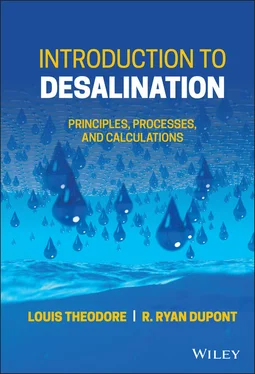This advanced separation technique may be used whenever low molecular weight solutes such as inorganic salts or small organic molecules (e.g. glucose) are to be separated from a solvent (usually water). In normal (as opposed to reverse) osmosis, water flows from a less concentrated salt solution to a more concentrated salt solution as a result of an innate concentration driving force (thermodynamically referred to as the chemical potential). As a result of the migration of water through the membrane, an “osmotic pressure” is created on the side of the membrane to which the water flows. In RO, the membrane is permeable to the solvent or water and relatively impermeable to the solute or salt. In order to make water pass through an RO membrane in the desired direction (i.e. away from a concentrated salt solution), a pressure must be applied that is higher than the osmotic pressure. The membranes used for RO processes are characterized by a high degree of semi-permeability, high water fluxes, good mechanical strength, chemical stability, and relatively low operating and capital costs. Early RO membranes were composed of cellulose acetate, but restrictions on process stream pressure, temperature, and organic solute rejection spurred the development of noncellulosic and composite material membranes (“sandwiches”). These membranes may be configured into a variety of geometries for system operation, including: plate and frame, tubular, spiral wound (composite), and hollow fiber.
1.5.3 Crystallization Processes
Crystallization processes were also employed over 2,000 years ago. Today, these processes are important mass transfer operations that are often employed in the preparation of a pure product. In the process, a crystal usually separates out as a substance of specific composition from a solution of varying composition. Any impurities in the liquid (often referred to as the mother liquor) are carried in the crystalline product only to the extent that they adhere to the surface or are occluded (retained) within the crystals that may have grown together during or after the crystallization operation. The separation of a solid from a solution onto a crystal occurs only if there is a state of imbalance involving a mass driving force; namely, a decrease in chemical potential (or concentration) between the bulk of the liquid solution and the crystal interface. This effectively means that the solution must be supersaturated. There are several different ways that crystallization can occur. The four most often encountered in practice are (Theodore 2014):
1 Cooling.
2 Evaporation.
3 Cooling and evaporation (also referred to as adiabatic evaporation).
4 A salting out process.
Process 1 is the most commonly employed, provided the solubility of the component being crystallized decreases with decreasing temperature.
World-wide development of desalination techniques in the last half century has been driven out of necessity due both to water scarcity and population growth. The private sector has primarily led the investment in research and development since water has begun to be seen not as a commodity, but as a product to be sold at a profit. This development by the private sector has led to a significant drop in the cost of water generated using these desalination techniques.
The following summary observations can be made related to water, seawater desalination, and water treatment in general.
1 Water demand at both the national and international levels is increasing at a faster rate than originally realized.
2 Water demand at both the national and international levels is increasing at a faster rate than population growth.
3 There is indeed growing water scarcity.
4 One approach to solving this water scarcity problem is to develop and/or find new sources of water.
5 Nonconventional water sources will become more attractive in the future.
6 Water conservation measures should be expanded in the future.
7 Seawater and brackish groundwater are nonconventional water sources serving as feedstock for desalination processes.
8 Poor seawater quality can limit RO applications but generally does not have as great an effect on evaporation and crystallization processes.
9 Desalination processes featured evaporation in earlier times, while RO is generally the process of choice today.
10 The increasing demand for potable water will ensure that improvements in current technologies and development of new approaches for potable water production will continue to develop in the future.
1.7 Illustrative Examples
Five illustrative examples complement the material presented in this chapter.
1.7.1 Illustrative Example 1
Describe the role process water plays in industrial processes/applications.
Solution . Process industries rank above all others as users of water. No process plant could operate without water as a cooling medium and as a direct raw material in certain phases of a process. The local water supply, therefore, must be studied before an area can even be considered as a possible site for a processing facility. A detailed estimate of present and future water requirements must precede a plant siting study. Then the availability of water in the region being considered should be carefully investigated. If well water is to be used, a complete study of the history of the groundwater table is necessary. If groundwater supplies are adequate, they are preferred because of their lower temperature and generally higher water quality as compared to surface water sources.
Surface waters from streams or lakes also require careful consideration since both their quantity and quality can vary greatly on a seasonal basis. Streams discharging into the ocean during times of low runoff can become saline as a result of seawater intrusion. Under such conditions, plant design may have to include large storage facilities for fresh water to be collected during periods of high runoff and used during dry seasons when the stream becomes saline.
Companies moving into relatively nonindustrialized areas often fail to consider the possibility of other plants following suit. The availability of the water supply should be adequate not only for the future needs of the proposed plant but also for the anticipated needs of other industries that might move into the area. It is also desirable to consider alternate sources of supply that may be required if the preferred water source becomes depleted. Water quality must be studied as well as water quantity. Chemical and bacteriological examination will indicate the extent of treatment required and can aid in the development of water cost figures for comparison with other locations. The possible contamination of the water source by other industries in the area should be anticipated. Note that “contamination” may consist of raising the temperature of the water to a level that renders its use as a cooling medium impossible.
1.7.2 Illustrative Example 2
A range of water needs typically exist within a facility, all of which may have different water quality requirements for specific uses. Describe five of these common needs.
Solution . Five common industrial facility water uses include:
1 Cooling Water. Natural and forced-draft cooling towers are generally used to provide the cooling water required at a site unless water can be drawn from a convenient river or lake in sufficient quantity to meet a facility’s cooling demands. Seawater or brackish water can be used at coastal sites but, if used directly, necessitates more expensive materials of construction for heat exchangers because of potential corrosion problems resulting from the high dissolved solids content of this water. Often, this cooling water does not have to be of high purity and can be taken from blowdown streams from boilers or process lines that require much more stringent water quality conditions.
Читать дальше












